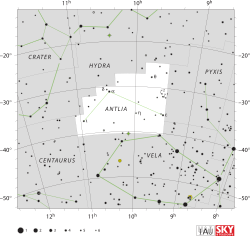Iota Antliae
Iota Antliae, Latinized from ι Antliae, is a single,[9] orange-hued star in the southern constellation of Antlia. It has an apparent visual magnitude of +4.60,[2] making it a faint naked eye star. From parallax measurements, the distance to this star can be estimated as 202 ± 2 light-years (61.93 ± 0.61 parsecs).[1] It is drifting further away with a radial velocity of 2 km/s.[1]
 | |
| Observation data Epoch J2000 Equinox J2000 | |
|---|---|
| Constellation | Antlia |
| Right ascension | 10h 56m 43.05097s[1] |
| Declination | –37° 08′ 15.9521″[1] |
| Apparent magnitude (V) | +4.60[2] |
| Characteristics | |
| Evolutionary stage | horizontal branch[3] |
| Spectral type | K1 III[4] |
| U−B color index | +0.84[2] |
| B−V color index | +1.03[2] |
| Astrometry | |
| Radial velocity (Rv) | 2.30±0.31[1] km/s |
| Proper motion (μ) | RA: +74.303±0.221[1] mas/yr Dec.: −125.185±0.259[1] mas/yr |
| Parallax (π) | 16.1823 ± 0.1882[1] mas |
| Distance | 202 ± 2 ly (61.8 ± 0.7 pc) |
| Absolute magnitude (MV) | +0.77[5] |
| Details | |
| Mass | 1.55[6] M☉ |
| Radius | 12.10+0.21 −0.65[1] R☉ |
| Luminosity | 66.7±0.9[1] L☉ |
| Surface gravity (log g) | 2.76[7] cgs |
| Temperature | 4,892[7] K |
| Metallicity [Fe/H] | −0.03[7] dex |
| Age | 3.32[6] Gyr |
| Other designations | |
| Database references | |
| SIMBAD | data |
The spectrum of Iota Antliae matches a stellar classification of K1 III,[4] indicating that this is an evolved star that is now in its giant phase. Having exhausted the supply of hydrogen at its core, the star has expanded and it now spans 12[1] times the radius of the Sun. It is a red clump giant, indicating it is on the horizontal branch and is generating energy through helium fusion.[3] The star is 3.32[6] billion years old with 1.55[6] times the Sun's mass. It is radiating 67[1] times the luminosity of the Sun from its swollen photosphere at an effective temperature of 4,892 K.[7]
References
- Brown, A. G. A.; et al. (Gaia collaboration) (August 2018). "Gaia Data Release 2: Summary of the contents and survey properties". Astronomy & Astrophysics. 616. A1. arXiv:1804.09365. Bibcode:2018A&A...616A...1G. doi:10.1051/0004-6361/201833051. Gaia DR2 record for this source at VizieR.
- Johnson, H. L.; et al. (1966), "UBVRIJKL photometry of the bright stars", Communications of the Lunar and Planetary Laboratory, 4 (99), Bibcode:1966CoLPL...4...99J.
- Kubiak, M.; et al. (June 2002), "Metal Abundance of Red Clump Stars in Baade's Window", Acta Astronomica, 52: 159–175, Bibcode:2002AcA....52..159K.
- Houk, Nancy (1979), Michigan catalogue of two-dimensional spectral types for the HD stars, 3, Ann Arbor, Michigan: Dept. of Astronomy, University of Michigan, Bibcode:1982mcts.book.....H.
- Anderson, E.; Francis, Ch. (2012), "XHIP: An extended hipparcos compilation", Astronomy Letters, 38 (5): 331, arXiv:1108.4971, Bibcode:2012AstL...38..331A, doi:10.1134/S1063773712050015.
- Luck, R. Earle (2015), "Abundances in the Local Region. I. G and K Giants", Astronomical Journal, 150 (3), 88, arXiv:1507.01466, Bibcode:2015AJ....150...88L, doi:10.1088/0004-6256/150/3/88.
- Alves, S.; et al. (April 2015), "Determination of the spectroscopic stellar parameters for 257 field giant stars", Monthly Notices of the Royal Astronomical Society, 448 (3): 2749–2765, arXiv:1503.02556, Bibcode:2015MNRAS.448.2749A, doi:10.1093/mnras/stv189.
- "iot Ant -- Star". SIMBAD. Centre de données astronomiques de Strasbourg. Retrieved 2012-06-29.
- Eggleton, P. P.; Tokovinin, A. A. (2008), "A catalogue of multiplicity among bright stellar systems", Monthly Notices of the Royal Astronomical Society, 389 (2): 869, arXiv:0806.2878, Bibcode:2008MNRAS.389..869E, doi:10.1111/j.1365-2966.2008.13596.x.